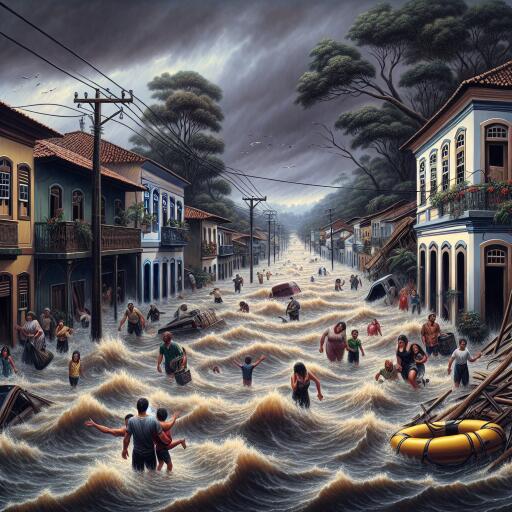
Unprecedented Floods Devastate Southern Brazil in a Century’s Worst Natural Calamity
In an alarming series of events, southern Brazil has been besieged by its most catastrophic floods in over 80 years, marking the fourth significant environmental calamity to strike the region within a single year. The relentless onslaught of floods since July has cumulatively claimed 75 lives, with the most recent deluge setting record-breaking water levels unseen since a historic flood in 1941.
The Brazilian Geological Service has reported that some areas are experiencing the highest water levels recorded in nearly 150 years, an unprecedented event that underscores the severity of the current crisis. In particular, the Taquari River valley has faced an overwhelming disaster, with cities such as Lajeado and Estrela submerged under floodwaters. A striking example of the devastation came as a dam at a hydroelectric plant situated between Bento Goncalves and Cotipora partially gave way under the pressure of the rising waters.
The calamity did not spare infrastructure; in the town of Feliz, located 50 miles from Porto Alegre, the state capital, a bridge crucial for connecting the local community to Linha Nova was demolished by the force of a raging river. The widespread destruction has led to significant utility outages, with electricity, communication, and water supply cuts affecting vast regions of the state. Over 23,000 residents have been compelled to evacuate their homes, leaving behind their lives as they knew them.
Isolated by the loss of internet, telephone service, and electricity, the affected communities have struggled to communicate their plight or seek assistance. Government and emergency services have been tirelessly working to provide aid, utilizing helicopters to rescue families trapped on rooftops and deliver essential supplies to those cut off by the floods.
The downpours began on Monday and, as forecasted by Marcelo Seluchi, chief meteorologist at the National Centre for Monitoring and Alerts of Natural Disasters, are expected to persist through Saturday. The situation prompted Eduardo Leite, the governor, to address the state’s residents, warning of the continuing adverse weather conditions and assuring them of the government’s determined response.
“As a human being, I am devastated inside, just like every [resident] is,” Governor Leite conveyed his personal distress over the catastrophe. Nonetheless, he affirmed his commitment to leading a robust response effort, emphasizing discipline and focus in the face of adversity.
Weather patterns across South America have been increasingly influenced by El Nino, a climatic phenomenon characterized by the warming of surface waters in the Equatorial Pacific, which has historically triggered droughts in the north of Brazil and heavier rainfall in the south. This year’s El Nino has been linked to unusually severe weather conditions, including a historic drought in the Amazon region. Experts suggest that such extreme weather events are becoming more frequent due to the impacts of human-caused climate change, highlighting the urgent need for comprehensive environmental and climate policies to mitigate future disasters.
The unfolding tragedy in southern Brazil serves as a stark reminder of the escalating challenges posed by climate change. As the world witnesses the increasing frequency and intensity of natural disasters, the call for immediate action to address the root causes of climate change has never been more urgent.





Leave a Reply